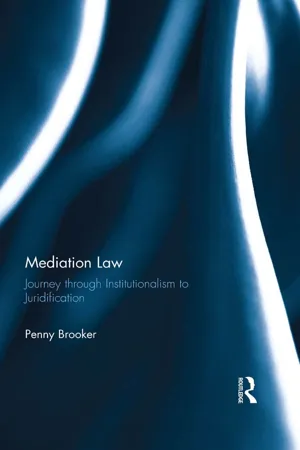
- 320 pages
- English
- ePUB (mobile friendly)
- Available on iOS & Android
About this book
In England mediation became a key part of the civil justice reform agenda after the Woolf Reforms of 1996, as disputants were deflected from litigation towards settlement outside the court system. The Civil Procedure Rules (CPR) give courts the power to 'encourage' mediation through judicial case management or use stronger measures by using costs to penalise parties who act unreasonably by refusing to use ADR or mediation. One of the effects of this institutionalisation is an emerging case law that defines how mediation is practiced as it is merges with the litigation process. When mediation first began to be used in England the parties either agreed to mediate by a contract before a dispute happened or decided to attempt the process as a way of resolving disagreements. Inevitably, some disputants either refused to abide by their contractual obligations or would not follow through with the settlement agreements reached through the process. This brought the authority of the law into a new area and the juridification process began.
This book explores how mediation law shapes the practice of mediation in the English jurisdiction. It provides a comprehensive examination of the legal framework for mediation, and explores the jurisprudence in order to analyse the extent that institutionalisation by the state and courts has led to the monopolisation by lawyers and a further 'juridification' process results. The book includes a comparative legal methodology on the framework underpinning mediation practise in other common law jurisdictions, including the United States, Australia, and Hong Kong, in order to explicate shared or distinctive approaches to mediation.
The book will be of great interest to academics and students of legal theory and dispute resolution.
Frequently asked questions
- Essential is ideal for learners and professionals who enjoy exploring a wide range of subjects. Access the Essential Library with 800,000+ trusted titles and best-sellers across business, personal growth, and the humanities. Includes unlimited reading time and Standard Read Aloud voice.
- Complete: Perfect for advanced learners and researchers needing full, unrestricted access. Unlock 1.4M+ books across hundreds of subjects, including academic and specialized titles. The Complete Plan also includes advanced features like Premium Read Aloud and Research Assistant.
Please note we cannot support devices running on iOS 13 and Android 7 or earlier. Learn more about using the app.
Information
1 Development of modern mediation
Introduction
Alternative to litigation in Common Law
Problems with litigation
Table of contents
- Cover
- Half Title
- Title Page
- Copyright Page
- Table of Contents
- Table of Cases
- Table of Legislation
- 1 Development of modern mediation
- 2 Initiating mediation through ADR clauses and court stays
- 3 Enforcing mediation settlement agreements
- 4 Legal ‘framework’ for mediating
- 5 The law surrounding mediation confidentiality
- 6 Conclusions
- References
- Index